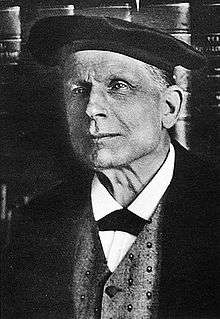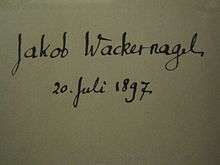Jacob Wackernagel



Jacob Wackernagel (German: [ˈvakərˌnaːɡəl]; also Jakob;[1] 11 December 1853 – 22 May 1938) was a Swiss linguist, Indo-Europeanist and scholar of Sanskrit. He was born in Basel, son of the philologist Wilhelm Wackernagel (1806–1869).
Biography
Wackernagel studied classical and Germanic philology and history in Göttingen and Leipzig, and taught at the University of Basel from 1879 onwards as professor of Greek, as the successor of Friedrich Nietzsche. In 1902 he was called to the University of Göttingen, but as a consequence of World War I he returned to Basel in 1915. He retired in 1936, and died on 22 May 1938 in Basel.
Work
Wackernagel's major work is the Altindische Grammatik, a comprehensive grammar of Sanskrit.
He is best known among modern linguists and philologists for formulating Wackernagel's law, concerning the placement of unstressed words (enclitic sentential particles) in syntactic second position in Indo-European clauses (Wackernagel 1892[2]).
Another law named after him (Wackernagel 1889[3]) is Wackernagel's law of lengthening (Dehnungsgesetz in German[4]), also sometimes known as the law of lengthening in composition (Regelung der Dehnung in der Zusammensetzung[5][6][7]): in some compound words in Greek the first ingredient ends with a vowel and the second ingredient begins with a vowel; when neither vowel is high the first vowel is without effect and the second is replaced by its long counterpart.[8]
Bibliography
- Jacob Wackernagel, Lectures on Syntax: with special reference to Greek, Latin, and Germanic, edited and translated by David Langslow, New York: Oxford University Press, 2009 (original edition: 1920–1924).
Notes and references
- ↑ His ex libris in 1897 and owner's name in his own hand has "Jakob" (cf. illustrations).
- ↑ Jacob Wackernagel, "Über ein Gesetz der indogermanischen Wortstellung", Indogermanische Forschungen 1, 1892, pp. 333–436
- ↑ Jacob Wackernagel (1889), "Das Dehnungsgesetz der griechischen Komposita", Programm zur Rektoratsfeier der Universität Basel, 1889:1–65. Reprinted in Jacob Wackernagel, Kleine Schriften. Vol. 2. Göttingen, 1953, pp. 897–961.
- ↑ Gregory Nagy, Greek. 2008.
- ↑ Geōrgios Rhousiadēs, Praktische grammatik der Neuhellenischen sprache, vol. 2. 1834. p. 110
- ↑ Jakob Wackernagel. Altindische Grammatik. Teil 1: Lautlehre. 1896. p. 312
- ↑ Robert Lawrence Trask, The dictionary of historical and comparative linguistics. 2000. p. 365
- ↑ Andrew L. Sihler. New comparative grammar of Greek and Latin. 1995. p. 82